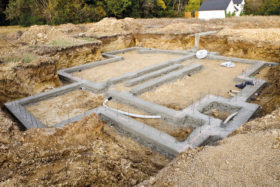
Early Bird Offer! Free tickets to meet independent experts at this summer's Build It Live
Save £24 - Book Now!
Early Bird Offer! Free tickets to meet independent experts at this summer's Build It Live
Save £24 - Book Now!Nothing can boost the character of your home’s interiors quite like your choice of flooring. In terms of style, durability and quality, timber flooring has long been a favourite in the self-build and renovation market, not least because of the range of options.
One of the beauties of timber flooring is that it is always unique, boasting infinite variations due to knotting, markings, grain and colour.
As these types of product are constantly undergoing technical development, both solid and engineered boards are easier to install than ever before, not to mention being available for a wide range of budgets.
In this environmentally conscious age, another benefit of using timber flooring is that it’s sustainable and recyclable at end of life.
To ensure that the product you’re purchasing is from a trustworthy source, check it has the Forest Stewardship Council (FSC) stamp of approval. This guarantees that the boards haven’t come from an illegal source, as its chain of custody has been tracked from growth to manufacture.
Before you select a floor, you need to think about the basics, such as where in the house you’re going to lay it. Are you using it in the high-traffic hallway, or the low-traffic spare bedroom? Is it going in a small enclosed zone or a large open-plan kitchen diner?
You also need to think about your heating system – if the floor planks are to be used in conjunction with underfloor heating (UFH), you need your new covering to be able to deal with the proximity to higher temperatures.
In relation to longevity and cost, are you hoping this floor will last forever, or do you expect to change it in the next five years or so? If it’s the former, then you’ll need to have a decent budget to secure the kind of high-quality item required.
In general, your choice of wooden flooring comes down to three options – solid, engineered or reclaimed. Each one has its own pros and cons.
Solid wood flooring is very much the darling of the group. Its aesthetic beauty is second to none and it adds an air of grandeur to a home that’s very hard to match.
Alternatives to wood flooringIf you like timber flooring but want a lower price tag, consider these alternatives:
|
It is graded for quality; as a rule of thumb, you get what you pay for. ‘Premium’ grades come from heartwood and are smooth, knot-free and close to uniform in colour, while grades described as ‘natural’ and ‘rustic’ possess a higher degree of knots and colour variation.
Another factor that will affect the cost of your solid flooring is what type of timber you choose.
Oak and walnut are traditionally the most desirable choices of hardwood – because of their depth of colour, durability and the character of the grain – but African tropical hardwoods such as sapele and iroko are rising in popularity.
Softwoods such as pine or fir are available in a more wallet-friendly price bracket. With a little research you should be able to source a product that’s both sustainable and local to your area, so you’ll be supporting home-grown industry, too.
However, as their name suggests, softwoods will show indentations and scratches more easily – opt to use it in low-traffic zones only.
Engineered wood boards consist of several layers of timber, pieced together to make a very robust product. The top layer is a thick veneer (up to 6mm) of the quality timber of your choice, often referred to as the ‘wear layer’.
Below this is a plywood base, built up with layers of hard or softwood boards that run in different directions, giving the products strength and stability, not to mention a rigidity that many solid timber equivalents do not possess.
In general, this type of board is more stable than solid planks – expanding and contracting less with changes in humidity and temperature – so it’s a perfect choice for flooring in a kitchen or bathroom. Engineered timber also makes a perfect marriage with UFH, as it won’t warp.
Three main factors affect the price of engineered boards: the thickness of the wear layer; the type of wood the wear layer is made from; and how many ‘strips’ of wood make up the veneer.
Three strip-boards are cheapest, because the narrower pieces that make up the wear layer produce less wastage, followed by two strip, and the most expensive, single sheet.
In terms of maintenance, solid wood flooring can be sanded and refinished infinite times, but there is a limit to how often you can do this to engineered boards – it all comes down to the thickness of the wear layer.
As a rule of thumb, if the layer is 4mm thick you can sand it up to three times, and layers of 6mm can be sanded perhaps five times without damaging the integrity of the product.
Reclaimed flooring offers all the characteristics of solid wood, but comes with character from its previous life. Since wood can be reclaimed from any number of sources, each floor is quite different.
‘Recycled’ and ‘reclaimed’ typically refer to materials sourced from dismantled buildings or other wood products that have served their original purpose and then been re-milled to make new flooring.
‘Salvaged’ flooring generally refers to existing boards that have been removed from an existing building and repurposed.
Sourcing just the right reclaimed product for your home may mean a little more work than buying off the shelf at a DIY shop. Thanks to a surge in demand for this type of flooring, it is becoming more easily available – the down side is that it is significantly more expensive than it was, say, two years ago.
It is usually bought in bundles from reclamation yards, but there are a number of specialist companies out there that offer whole-floor installations.
Because this type of flooring has already enjoyed a life as something else, reusing it in this way is essentially recycling it, making it a very green choice.
The majority of problems that homeowners experience with timber flooring are due to poor fitting, unfamiliarity with the subfloor or a dearth of preparation.
Before laying your flooring, it is essential to give it time to acclimatise to the room in which it’s being installed. Allow at least three days for engineered boards and up to two weeks for solid timber.
If you fit damp or unacclimatised planks they are likely to contract excessively, causing unsightly gaps to appear between the sections.
Different types of timber flooring require different subfloors and laying techniques. Ensure that the surface is even before starting work – if it’s not, it will need levelling out with underlay or ply.
If the floor is even and the boards are more than 18mm thick, solid boards can be glued to concrete floors over a damp-proof membrane, or nailed to joists. Engineered boards can be fixed to float over most subfloors or even old boards.
Laying timber flooring is well within the grasp of a competent DIYer, especially engineered boards that are often tongue and groove.
If possible, lay your flooring before installing skirting as this will give you a neater and more professional finish, not to mention making the job slightly easier.
Finally, if you are carrying out a major renovation or self-build and are installing wet underfloor heating, allow enough time for the screed to dry out properly prior to fitting the flooring.
Once it’s laid, switch the UFH on gradually; start by putting it on the lowest setting for a week, building up to the highest over the course of about a month.
Photo: Kahrs’ Grande Espace one-strip oak wood flooring


Comments are closed.